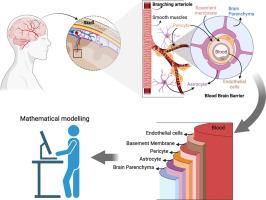European Journal of Pharmaceutics and Biopharmaceutics ( IF 4.4 ) Pub Date : 2022-03-10 , DOI: 10.1016/j.ejpb.2022.03.004 Mohsen Sarafraz 1 , Maryam Nakhjavani 2 , Sarah Shigdar 2 , Farid C Christo 3 , Bernard Rolfe 1

|
The blood-brain barrier (BBB) is a strong barrier against the entrance of drugs, which has made brain cancer treatment a major challenge. We have previously shown that targeting transferrin receptors using aptamers increased brain drug delivery. To get a better understanding of this phenomenon, in the present article, a mathematical model based on the finite element method was developed accounting for the fluid flow and mass transport of the aptamer molecule inside an 8 µm capillary vessel across a 14 µm blood-brain barrier domain. The fluid flow and mass transport equations were coupled to calculate the blood velocity and aptamer concentration profiles across the BBB. It was identified that the thickness of the astrocyte and endothelial cell layers are key parameters affecting the concentration of the aptamer delivered to the last neuron dendrites in the BBB. The predicted efficacy of the drug delivery (Capt/Cin) of 10.9% to 13.8% was calculated at a porosity of 0.5 to 0.9, respectively, at a blood velocity of 0.38 mm/s, which was independent of the inlet concentration of the aptamer. This low efficacy was attributed to the mass transfer resistance across endothelial cells, astrocyte and pericyte layers, which decreased the concentration by 6.7%. It was also identified that the main mechanism of drug delivery is switched from convective mass transport in the capillary layer (with Peclet number > 50) to mixed convection mass transport (1 < Peclet number < 5) in the porous layers and to diffusion only once aptamer reached the brain parenchyma (Peclet number < 1).
中文翻译:

用于肿瘤治疗和癌症治疗的血脑屏障中适体的质量传输和分布建模
血脑屏障(BBB)是阻止药物进入的强大屏障,这使得脑癌治疗成为一项重大挑战。我们之前已经表明,使用适体靶向转铁蛋白受体增加了脑药物输送。为了更好地理解这一现象,在本文中,开发了一个基于有限元方法的数学模型,用于解释适配体分子在 8 µm 毛细血管内穿过 14 µm 血脑的流体流动和质量传递。屏障域。耦合流体流动和质量传递方程以计算穿过 BBB 的血液速度和适体浓度分布。已确定星形胶质细胞和内皮细胞层的厚度是影响递送至 BBB 中最后神经元树突的适体浓度的关键参数。药物递送的预测功效(分别在 0.5 至 0.9 的孔隙率和 0.38 mm/s 的血流速度下计算出 10.9% 至 13.8% 的C apt /C in ),这与适体的入口浓度无关。这种低功效归因于跨内皮细胞、星形胶质细胞和周细胞层的传质阻力,使浓度降低了 6.7%。还发现药物递送的主要机制从毛细管层中的对流传质(Peclet 数 > 50)转变为多孔层中的混合对流传质(1 < Peclet 数 < 5),并且仅扩散一次适体到达脑实质(佩克莱特数<1)。











































 京公网安备 11010802027423号
京公网安备 11010802027423号